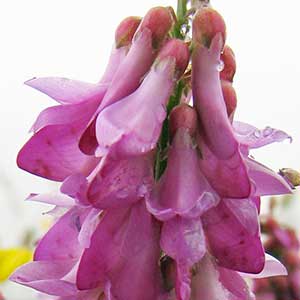Hedysarum occidentale
Hedysarum sulphurescens
western hedysarum, western sweet-vetch
sulfur sweetvetch, sulphur hedysarum, sulphur sweet-vetch, white sweetvetch, yellow hedysarum, yellow sweet-vetch
decumbent to erect, (1.2–)2–9.5 dm.
ascending to erect, 1–6(–9) dm.
3.5–23 cm;
stipules 10–17 mm;
leaflets 9–19, blades lanceolate to ovate, elliptic, or oblong, 5–40 × 3–16 mm, veins conspicuous, surfaces usually pubescent, rarely glabrous adaxially.
(3–)7–12 cm;
stipules 8–15 mm;
leaflets (5–)9–17, blades elliptic or lanceolate-oblong, 9–40 × 4.5–15(–21) mm, veins conspicuous, surfaces strigose abaxially, glabrous adaxially.
10–50-flowered, axis 4–25 cm in fruit;
bracts 1–4 mm.
(6–)10–60-flowered, axis 2.5–22 cm in fruit;
bracts 2–6 mm.
(3–)6–15 cm.
4.5–16 cm.
1–3.5 mm.
1–3.5(–4) mm.
usually declined at anthesis;
calyx 3.5–11 mm;
tube 3–9 mm, puberulent;
lobes subulate to triangular, 0.5–2 mm, equal or nearly so;
corolla usually lavender-pink or lilac- to pink-purple, rarely white, 16–25 mm;
wing auricles connate, linear, nearly equal or equal to claw.
usually declined at anthesis;
calyx 3–6 mm;
tube 1.5–4 mm, puberulent;
lobes triangular to subulate, 1–2.5(–3) mm, equal or nearly so;
corolla yellow to pale yellow, 14–20 mm;
wing auricles connate, linear, nearly equal or equal to claw.
segments (1 or)2–5, 7–14.5(–18) × 5.6–10.2(–11) mm, margins conspicuously winged, prominently reticulate, pubescent or glabrous.
segments 1–4, 7–13 × 5.5–9 mm, margins conspicuously winged, prominently reticulate, glabrous.
Hedysarum occidentale
Hedysarum sulphurescens
Varieties 2 (2 in the flora).
(Discussion copyrighted by Flora of North America; reprinted with permission.)
Hedysarum sulphurescens is a near ally of H. occidentale, with which it shares a large portion of its range, and from which it differs mainly in flower color. The two taxa are apparently partitioned by subtle habitat differences and seldom occur closely juxtaposed. The morphological differences, though small and of little consequence in other plant groups, seem to support evolutionary processes that keep them separate.
(Discussion copyrighted by Flora of North America; reprinted with permission.)
1. Leaflet blades usually 2–4 times longer than wide, not or rarely thickened, not especially deciduous; flowers 16–22 mm, usually lilac- to pink-purple, rarely white; widespread. | var. occidentale |
1. Leaflet blades mostly 1–2 times longer than wide, becoming thickened, early deciduous; flowers (17–)20–25 mm, pale lavender-pink; w Colorado, e Utah. | var. canone |


